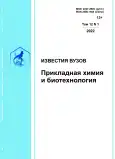Synthesis and biological testing for pesticidal activity of 8-azasteroids
- Authors: Pyrko A.N.1
-
Affiliations:
- International Sakharov Environmental Institute of Belarusian State University
- Issue: Vol 12, No 1 (2022)
- Pages: 8-14
- Section: Chemical Sciences
- URL: https://bakhtiniada.ru/2227-2925/article/view/301113
- DOI: https://doi.org/10.21285/2227-2925-2022-12-1-8-14
- ID: 301113
Cite item
Full Text
Abstract
Keywords
About the authors
A. N. Pyrko
International Sakharov Environmental Institute of Belarusian State University
Email: pyrko@yandex.ru
References
- Ibrahim-Ouali M. Total synthesis of steroids and heterosteroids from BISTRO. Steroids. 2015;98(6):9- 28. https://doi.org/10.1016/j.steroids.2015.02.014.
- Kaplan W., Khatri H. R., Nagorny P. Concise enantioselective total synthesis of cardiotonic steroids 19-hydroxysarmentogenin and trewianin aglycone. Journal of the American Chemical Society. 2016;138 (22):7194-7198. https://doi.org/10.1021/jacs.6b04029.
- Khatri H. R., Bhattarai B., Kaplan W., Li Zh., Long M. J., Aye Y., et al. Modular total synthesis and cell-based anticancer activity evaluation of ouabagenin and other cardiotonic steroids with varying degrees of oxygenation. Journal of the American Chemical Society. 2019;141(12):4849-4860. https://doi.org/10.1021/jacs.8b12870.
- Iqbal A., Siddiqui T. A review on synthesis and biological activities of D-ring modified pregnenolone. Steroids. 2021;170(6):108827. https://doi.org/10.1016/j.steroids.2021.108827.
- Martinez-Gallegos A. A., Guerrero-Luna G., Ortiz-Gonzalez A., Cardenas-Garcia M., Bernes S., Hernandez-Linares M. G. Azasteroids from diosgenin: synthesis and evaluation of their antiproliferative activity. Steroids. 2021;166(2):108777. https://doi.org/10.1016/j.steroids.2020.108777.
- Brito V., Santos A. O., Almeida P., Silvestre S. Novel 4-azaandrostenes as prostate cancer cell growth inhibitors: synthesis, antiproliferative effects and molecular docking studies. Comptes Rendus Chimie. 2019;22(1):73-83. https://doi.org/S1631074818301838.
- Huang L. H., Xu H.-D., Yang Z.-Ya., Zheng Y.-F., Liu H.-M. Synthesis and anticancer activity of novel C6-piperazine substituted purine steroid–nucleosides analogues. Steroids. 2014;82(4):1-6. https://doi.org/10.1016/j.steroids.2013.12.004.
- Yao Zh., Xu Y., Zhang M., Jiang Sh., Nicklaus M. C., Liao C. Discovery of a novel hybrid from finasteride and epristeride as 5α-reductase inhibitor. Bioorganic & Medicinal Chemistry Letters. 2011;21(1):475-478. https://doi.org/10.1016/j.bmcl.2010.10.112.
- Mikhalschuk A. L. On the 95th birthday of Afanasy Andreevich Akhrem. Chemistry of Heterocyclic Compounds. 2008;44:243-246. https://doi.org/10.1007/s10593-008-0039-z.
- Mikhal’chuk A. L. The most important publications of A. A. Akhrem on the chemistry of heterocyclic compounds. Chemistry of Heterocyclic Compounds. 2008;44:247-252. https://doi.org/10.1007/s10593-008-0040-6.
- Lakhvich F. A., Lis L. G., Akhrem A. A. Total synthesis of 8-аzasteroids. Russian Chemical Reviews. 1984;53(6);582-612. http://dx.doi.org/10.1070/RC1984v053n06ABEH003076.
- Gulyakevich O. V., Mikhal'chuk A. L. Mechanism for annelation (cyclocondensation of schiff bases by β-dicarbonyl and β,β′-tricarbonyl compounds in amphiprotic media (review). Chemistry of Heterocyclic Compounds. 2008;44:253-262. https://doi.org/10.1007/s10593-008-0041-5.
- Akhrem A. A., Lakhvich F. A., Pyrko A. N., Lis L. G. Нeterocyclic analogs of steroids. xiii. new synthesis of 8-aza-16-oxasteroids. Russian Journal of Organic Chemistry. 1985;16(18):2565-2570. https://doi.org/10.1002/chin.198518300.
- Akhrem A. A., Borisevich N. A., Gulyakevich O. V., Mikhal'chuk A. L., Raichyonok T. F., Tikhomirov S. A., et al. Specific fluorescence properties and picosecond transient absorption of 8-azasteroids. Journal of Fluorescence. 1999;9:357-361. https://doi.org/10.1023/A:1020596210145.
- Rao H. S. P., Senthilkumar S. P. Review on the synthesis of 8-azasteroids. Current Organic Chemistry. 2004;8(15):1521-1528. https://doi.org/10.2174/1385272043369881.
- Aksenov N. A., Malyuga V. V., Abakarov G. M., Aksenov D. A., Voskressensky L. G., Aksenov A. V. Synthesis of 3,4-dihydroisoquinolines using nitroalkanes in polyphosphoric acid. Russian Chemical Bulletin. 2019;68:1047-1051. https://doi.org/10.1007/s11172-019-2518-z.
- Shimizu M., Orita H., Hayakawa T., Suzuki K., Takehira K. Oxidation of 1,2,3,4-tetrahydroisoquinolines to 3,4-dlhydrolsoqulnollnes with molecular oxygen catalyzed by copper(i1) chloride. Heterocycles. 1995;41(4):773-779. https://doi.org/10.3987/COM-94-6991.
- Akhrem A. A., Moiseenkov A. M., Krivoruchko V. A., Lakhvich F. A., Poselenov A. I. Approach to synthesis of 8-azasteroids. Russian Chemical Bulletin. 1972;21(9):2078-2083. https://doi.org/1007/BF00854629.
- Pyrko A. N. Method of preparation of cyclic β-triketones. Zhurnal organicheskoi khimii = Russian Journal of Organic Chemistry. 1991;27(10):1981- 1982. (In Russian).
- Akhrem A. A., Titov Yu. A. Total steroid synthesis. New York: Plenum Press; 1970. 306 p.
- Blickenstaff R. T., Ghosh A. C., Wolf G. C. Total synthesis of steroids. New York: Academic Press; 1974. 318 p.
- Pshenichny V. N., Gulyakevich O. V., Khripach V. A. Interaction of 6,7-dimethoxy-3,4-dihydroxy isoquinoline with enamines 2-acetyl-5,5-dimethyl- 1,3-cyclohexanediones. Proceedings of the Academy of Science of BSSR. Chemical series. 1986;(5):114-116.
- Gulyakevich O. V., Mikhal'chuk A. L., Khripach V. A. Enamino ketones. Annelation of cyclic Shiff bases with 2(1-aminoethylidene)-1,3-cyclohexanones. Zhurnal organicheskoi khimii = Russian Journal of Organic Chemistry. 1991;27(1):187-188. (In Russian).
- Borisevich N. A., Raichyonok T. F., Sukhodola G. B., Tolstorozhev V. A., Shashilov A. A. Absorption and fluorescence of 8-azasteroids in the gas phase. Journal of Applied Spectroscopy. 2005;72 (1):49-58. https://doi.org/10.1007/s10812-005-0030-8N.
- Borisevich N. A., Dubovskii V. L., Mikhal'chuk A. L., Raichenok T. F., Tikhomirov S. A., Tolstorozhev G. B. Photochemical processes in aqueous solutions of immunoactive 8-azasteroid. Journal of Applied Spectroscopy. 2003;70:545-549. https://doi.org/10.1023/a:1026146430668.
- Bagnich S. A., Gulyakevich O. V., Mikhalchuk A. L. Spectral-luminescent properties of 12- oximino derivatives of 8-Aza-D-Homogona-12,17a- Diones and their concentration dependence. Journal of Fluorescence. 2008;18:277-283. https://doi.org/10.1007/s10895-007-0267-0.
Supplementary files









